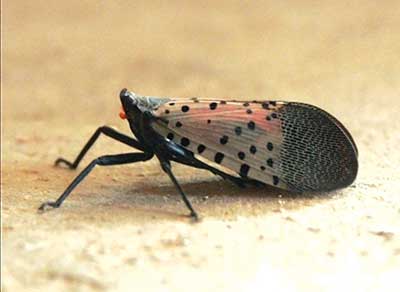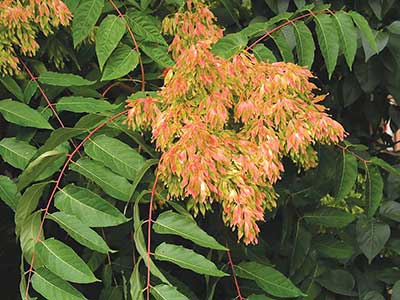 |
| Spotted lanternfly, screenshot of photo by Henripekka Kallio from https://commons.wikimedia.org/wiki/File:Perho.jpg, licensed under the Creative Commons Attribution-Share Alike 3.0 Unported license |
 |
| Tree-of-heaven, seed-bearing female plant, photo by Luis Fernández García from https://commons.wikimedia.org/w/index.php?curid=139593, licensed under the Creative Commons Attribution-Share Alike 2.1 Spain license. |
By C.J. Walke
As winter rolls into spring, work in the orchard transitions from pruning and scionwood gathering to preparations for the warming soil and for that first shine of green tissue as buds move from silver tip to green tip or swollen bud to bud burst. At this time of year, MOFGA’s organic orcharding classes are in full swing, and various educational workshops on pruning, grafting and orchard care are offered around the state. This is also the time of year to be prepared for the arrival of orchard pests looking to call your orchard home and your fruit their nursery.
One pest of increasing concern is the spotted lanternfly (Lycorma delicatula), an invasive, sap-feeding planthopper that is native to Asia and was first sighted in southeastern Pennsylvania in the fall of 2014. Since then, spotted lanternfly has been detected in Connecticut, Delaware, Maryland, New Jersey, New York and Virginia, despite intense efforts by states to quarantine infected areas to reduce the spread of this pest. Experts believe this new invasive pest has the potential to threaten the tree fruit, horticulture and timber industries of the Northeast.
Spotted lanternfly adults and nymphs feed on the leaves and stems of plants by sucking out the plant sap with their straw-like mouth parts. The feeding causes wilting, dieback and eventual death of the plant after prolonged exposure, but the more immediate sign of trouble is the profuse amount of honeydew secreted by the pest as it feeds. This honeydew accumulates on leaves and fruit, similar to the feeding activity of pear psylla, and can reduce fruit quality and increase leaf damage. The honeydew also promotes the growth of sooty mold, which also damages leaves and fruit, and attracts other potential pests.
Adults are about 1 inch long with a black head and black-spotted gray wings. Their hind wings are tipped with bright red, but these are only visible when the insects fly or spread their wings. From late September to early October, females lay masses of 30 to 50 waxy eggs covered with a protective coating that looks like mud, usually on smooth sections of tree bark, stone or other vertical surfaces. This egg-laying characteristic is of primary concern for controlling the spread of the pest because the eggs are not contained to plants but will be laid on trucks and campers or materials hauled by trucks and moved about by human activity.
In Pennsylvania, eggs hatch in May, and the first nymphs are black with white spots and do not have wings. The nymphs turn bright red in their later instar stages, similar to the red on the hind wing of the adult, and adults start appearing in July. This lanternfly feeds on a wide variety of crops and has been found on over 40 plant species, including grape vines, apple trees, stone fruit trees and hops.
Research is showing that the lanternfly has a unique association with the tree-of-heaven (Ailanthus altissima), an invasive tree species with a native habitat ranging from China to Australia. This is a fast-growing, prolific seed producer that often grows in clumps or clonal clusters. Its leaves are pinnately compound with smooth edges and a characteristic foul odor when crushed. This helps distinguish tree-of-heaven from other trees with compound leaves, such as sumac, black walnut and hickory.
States currently unaffected by spotted lanternfly are using this association with tree of heaven as a primary source for locating areas where lanternfly may be spotted first. Research suggests that the lanternfly may need tree-of-heaven to complete its life cycle, or it may need sap from tree-of-heaven to acquire compounds that help protect it from predators. In Maine the Department of Agriculture, Conservation and Forestry (DACF) is tracking locations of tree-of-heaven and asks residents to report known plantings to [email protected].
Lanternfly activity in orchards has been observed mostly in Pennsylvania, and the pest seems to be moving through orchards rather than taking up residence. The pest was first found in commercial apple orchards in Pennsylvania in September 2017, but the adults did not spend much more than a week moving through those orchards and on to other host locations. However, they were laying eggs along the way, and nymphs were found the following season.
In 2018 Pennsylvania State University Cooperative Extension conducted extensive research on the efficacy of 20 pesticides, looking at initial rates of knockdown for the pest and at residual effects on nymphs and adults in the week after spray applications. (See the resources at the end of this article for details.) The only OMRI-approved materials tested in the study were Entrust (spinosad) and Venerate XC (Burkholderia spp. strain). Entrust performed better but had only 58 percent mortality on nymphs immediately after spray application and no residual effect seven days later, with minimal mortality of adults. Currently no OMRI-approved materials are labeled for use against spotted lanternfly. (The materials in the Pennsylvania study were OMRI-approved for other pests.)
What can we do? The best approach seems to be education and awareness about this new potential pest to our area. The resources below provide up-to-date information and excellent color photos to help identify eggs, nymphs and adults, as well as tree-of-heaven. Scout and report detections of spotted lanternfly and tree-of-heaven to the Maine DACF.
Resources
Spotted Lanternfly on Grapes and Tree Fruit, by Julie Urban et al., PennState Extension, Dec. 2017
Updated Insecticide Recommendations for Spotted Lanternfly on Tree Fruit, by Dave Biddinger and Heather Leach, PennState Extension, Jan. 2019
Tree-of-Heaven, by David Jackson and Art Gover, PennState Extension, Oct. 2018
C.J. Walke is MOFGA’s organic orchard educator and farm manager at College of the Atlantic. You can contact him at [email protected].
